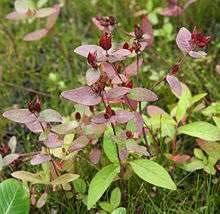Triadenum fraseri
| Triadenum fraseri | |
|---|---|
 | |
| Fraser's St. John's wort (Triadenum fraseri) | |
| Scientific classification | |
| Kingdom: | Plantae |
| (unranked): | Angiosperms |
| (unranked): | Eudicots |
| (unranked): | Rosids |
| Order: | Malpighiales |
| Family: | Hypericaceae or Clusiaceae |
| Genus: | Triadenum |
| Species: | T. fraseri |
| Binomial name | |
| Triadenum fraseri (Spach) Gleason | |
Triadenum fraseri, known by the common names of bog St. John's wort, Fraser's St. John's wort, or Fraser's marsh St. John's wort, is a perennial flowering plant in the family Clusiaceae that appears natively in New England, northeastern and north Central United States and lower Canada in wetlands habitats of "bogs, marshes, swales, sedgy meadows, moist sandy (even marly) shores, conifer swamps and alder thickets".[2] The species common name is named after John Fraser (1750–1811), a Scottish botanist and widely travelled plant collector.
Description
Triadenum fraseri is a perennial forb (an herb that flowers) can grow to heights of 1 foot (0.30 m) to 2 feet (0.61 m). The plant has blue-green (sometimes purple-tinged) stalkless, elliptical, opposite leaves that are typically 2.5 inches (6.4 cm) long and to 1.75 inches (4.4 cm) wide, with prominent, often red stems and veins.
The plant displays clusters of a few to several flowers arising from leaf axils, at the end of branching stems. The pink five-petal flowers with green or purplish sepals that range from 0.25 inches (0.64 cm) to 0.75 inches (1.9 cm) wide when fully open (but they are rarely open). The flower typically appears closed like a bud. Each flower features 9 to 12 yellow stamens. The plant's fruit is a three-sectioned dark-red or orange pointed capsule, 0.25 inches (0.64 cm) to 0.5 inches (1.3 cm) long. Triadenum fraseri is typically in flower each year from July through September.[3]
The plant is autotrophic and employs C3 carbon fixation.[3] The C3 plants originated during Mesozoic and Paleozoic eras and tend to thrive in areas where sunlight intensity is moderate, temperatures are moderate, and ground water is plentiful. C3 plants lose 97% of the water taken up through their roots to transpiration.[4]
Taxonomy
Triadenum fraseri is one of 200,000 Angiosperm species classified under the Class Dicotyledonae (or dicots) whose defining feature is that the seed has two embryonic leaves or cotyledons. The genus name Triadenum is derived from the Greek meaning "three glands".[5] This name refers to the plant's three-chambered capsule fruit. The name of this plant, both in the species name of fraseri and its common name of "Fraser's Saint John's wort" were given in honor of 18th- and early 19th-century Scottish botanist John Fraser (1750–1811). During his career, Fraser served Russian monarchs and collected plant specimens in during voyages through North America, the West Indies, and Russia. Fraser was hailed early on by his biographers as "one of the most enterprising, indefatigable, and persevering men that ever embarked in the cause of botany and natural science".[6]
There is disagreement among botanists and biologists on whether to classify this species (along with other Hypericum species) in the family Clusiaceae or Hypericaceae. Triadenum fraseri is closely related to Triadenum virginicum—known by the common name "Virginia marsh St. John's-wort"—which has also caused confusion.
Botanists have applied several synonyms in identifying Triadenum fraseri, including:[7][8]
- Elodea fraseri Spach
- Hypericum fraseri (Spach) Steud.
- Hypericum virginicum var. fraseri (Spach) Fernald
- Triadenum virginicum ssp. fraseri (Spach) J. Gillett
- Triadenum virginicum var. fraseri (Spach) Cooperr.
Distribution and habitat
Triadenum fraseri thrives in wetlands habitats of "bogs, marshes, swales, sedgy meadows, moist sandy (even marly) shores, conifer swamps and alder thickets".[2]
The United States Department of Agriculture describes Triadenum fraseri as a native species within the states of Connecticut, Illinois, Indiana, Iowa, Maine, Massachusetts, Michigan, Minnesota, Nebraska (rare), New Hampshire, New Jersey (rare), New York, North Carolina (rare), Ohio, Pennsylvania, Rhode Island, Tennessee (rare), Vermont, Virginia (rare), Washington, West Virginia, and Wisconsin, in the United States; and in the provinces of British Columbia, Manitoba, New Brunswick, Nova Scotia, Ontario, Quebec, Newfoundland, Prince Edward Island, Saskatchewan (rare), in Canada; and in the French overseas territories of Saint Pierre and Miquelon.[7] It is categorized as an "obligate wetland" plant by the U.S. Army Corps of Engineers for the Atlantic and Gulf Coastal Plain, Eastern Mountains and Piedmont, Great Plains, Midwest, Northcentral and Northeast; and Western Mountains, Valleys, and Coast regions.[9]
See also
References
- ↑ "Triadenum fraseri". NatureServe Explorer: An online encyclopedia of life. 7.1. NatureServe. February 2015. Retrieved 28 October 2015.
- 1 2 A. A. Reznicek, E. G. Voss, & B. S. Walters. "Hypericaceae: Triadenum: Triadenum fraseri (Spach) Gleason", Michigan Flora Online (University of Michigan, February 2011). Retrieved October 19, 2015.
- 1 2 Louis Iverson, David Ketzner, and Jeanne Karnes, "ILPIN information on Triadenum fraseri", Illinois Plant Information Network (published on United States Forest Service webspace). Retrieved October 28, 2015.
- ↑ J.A. Raven, D. Edwards, "Roots: evolutionary origins and biogeochemical significance", Journal of Experimental Botany vol 42, issue 90001 (2001) 381–401. PMID 11326045, DOI 10.1093/jexbot/52.suppl_1.381
- ↑ Wisconsin State Herbarium, University of Wisconsin at Madison, "Triadenum fraseri (Spach) Gleason", Flora of Wisconsin: Consortia of Wisconsin Herbaria. Retrieved October 28, 2015.
- ↑ J.C. Loudon, Arboretum et Fruticetum Britannicum, (53 MB file from archive.org), v. 1, 2nd ed., (London: Henry G. Bohn, 1854), pp. 119–122, at 120. Retrieved October 28, 2015. Full text and other formats available at archive.org.
- 1 2 United States Department of Agriculture, Natural Resources Conservation Service, Plant Profile: Triadenum fraseri (Spach) Gleason, Fraser's marsh St. Johnswort, Plants Database. Retrieved October 28, 2015.
- ↑ Interagency Taxonomic Information System, Triadenum fraseri (Spach) Gleason: Taxonomic Serial No.: 21473. Retrieved October 28, 2015.
- ↑ U.S. Army Corps of Engineers National Wetland Plant List, Version 3.2. Retrieved October 28, 2015.
